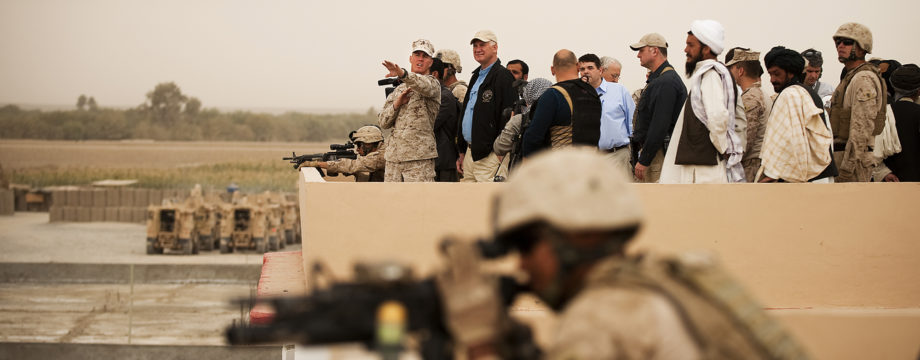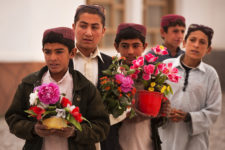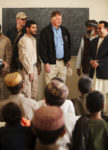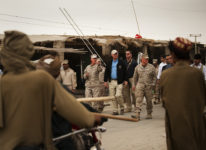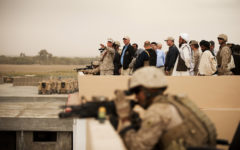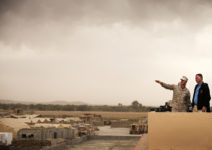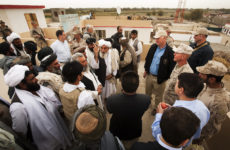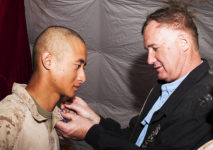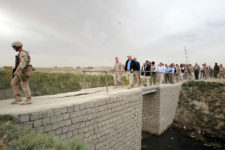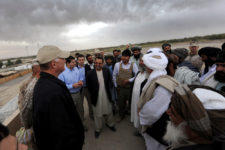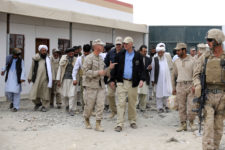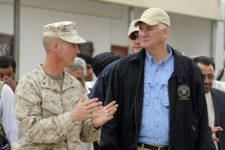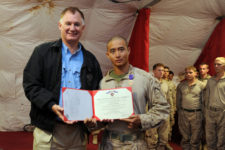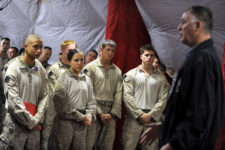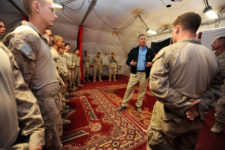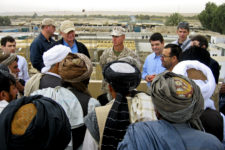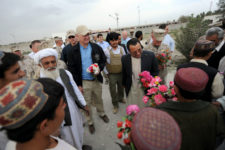“On 28 October, the Deputy Secretary of Defense the Honorable William J. Lynn III visited the Nawa District Center. The Regimental Combat Team 1 (RCT 1) staff arrived to accompany the battalion staff in hosting the Deputy Secretary for his visit. Following his departure, the RCT 1 staff remained in Nawa until 30 October to tour the battalion AO.” — Source: 3/3 Command Chronology for the Period of 1 October 2010 through 1 December [sic] 2010
Contents
Command Chronology
"On 28 October, the Deputy Secretary of Defense the Honorable William J. Lynn III visited the Nawa District Center. The Regimental Combat Team 1 (RCT 1) staff arrived to accompany the battalion staff in hosting the Deputy Secretary for his visit. Following his departure, the RCT 1 staff remained in Nawa until 30 October to tour the battalion AO." — Source: 3/3 Command Chronology for the Period of 1 October 2010 through 1 December [sic] 2010
News
Lynn Sees Counterinsurgency Success in Afghan Village
By Jim Garamone || 28 October 2010
NAWA, Afghanistan – Marine Corps Lt. Col. Jeff Holt was showing Deputy Defense Secretary William J. Lynn III the lay of the land of this village in Helmand province from atop the district government center.
“We’re going to walk you to the east side for a better look at the future,” the colonel said.
While the colonel was talking only about Nawa, it may be a look at what the future could hold for the whole country. Lynn’s view from the roof was the culmination of a visit that began with a walk through the town.
Operations in Nawa showed the power of integrating security, development, and governance issues, Lynn said. “It’s a place where the Marines are providing security, you have a pretty vibrant local government that’s fully engaged, and you have a provincial reconstruction team that’s experienced and deep, and all three are working together,” he said.
Local Afghan leaders reached out beyond their tribes. The Marines were proactive not only in their security mission, but their governance and engagement mission, as well, Lynn said. “They know and understand from the young lance corporal all the way up that the counterinsurgency is more than the kinetic side,” he said. “It involves the protection of the population and the nurturing of the population, and they did a great job in that.”
Two years ago, more than 1,000 Marines assaulted into this area. The town was deserted, the fields were planted with poppies, and drug traffickers were in cahoots with the Taliban. The Marines won a tough fight, then started to put the counterinsurgency strategy into practice.
First, the Marines provided security in Nawa. They disarmed improvised explosive devices, patrolled the streets, and killed or captured Taliban hard liners. Then they put the word out that the area was open for business. Soon people were moving back to the area.
The Marines and Helmand provincial reconstruction team members identified tribal and natural leaders in the community and they connected those people to the provincial government.
The Marines also sponsored small projects from the commanders’ emergency response program. They hired people to clean the canal that runs through the middle of town and for others to repair the bridges connecting the two sides of the city. It was money in the villagers’ pockets, and soon they had places to spend it as shop owners moved into a dilapidated garage-looking structure that lined both sides of the canal.
And still more people came back. The Marines and PRT members worked with Helmand Gov. Ghulab Mangal to eradicate poppies and opium production as a livelihood in the area. Local farmers planted their fields with wheat in the summer and corn as a winter crop. They brought back livestock and began growing silage and building places to store it.
District Governor Haji Abdul Manaf rose to the top of the district council and started working with his neighbors to aid the Marines and complete the security job. The Afghan government sent the army and national police to work alongside the Marines.
Soon Manaf presided over a civil council with more than 50 elders who gathered every two weeks to work together for Nawa. The council includes all tribes who live in the area and follows the traditional consensus-building approach that Afghans have used for generations.
More shops opened in old buildings along the canal. They built a school, hired teachers and began instruction. The town started a civic improvements effort to build new shops. An animal bazaar opened that soon attracted 5,000 people every Friday.
And the security mission has changed as well. Holt’s task Force 33 – built around the 3rd Battalion, 3rd Marines from Hawaii – now has only about 100 Marines near the city. The rest have eased out to smaller villages in the region, extending the security perimeter and thus bringing development to more people.
Afghan security forces – including police recruited from Nawa, trained at nearby Camp Leatherneck, and now patrolling their hometown streets – have taken the place of the Marines.
The future for Nawa that Lynn saw included a new police station, and cranes raised over construction sites that included a courthouse and a meeting center.
The future also includes a new elementary school with children eager to learn. As Mangel and Lynn approached the school, children came out and threw rose petals on them and presented them with bouquets.
In Washington last week, Lynn approved funds for building a paved highway between Nawa and Helmand’s capital of Lashkar Gah. When the civil leaders learned that the deputy secretary was the man who approved their request, they showered him with thanks and told him the name of the connection would be Marine Highway.
Lynn also saw the site of a grand mosque; farmers tending their fields and bringing in the corn crop; and orchards planted with pomegranate, apple and other fruit trees.
Nawa is not perfect. The canal – once dredged – is full of plastic garbage, and reeds have taken new growth. The town council would like to make the canal walls cement, but there is no money for it. Any extra will have to be spend on equipment and projects that have not been properly maintained.
There still are those who want the old days back. The old powerbrokers, drug traffickers, and Taliban would slip back in if they could. The interfaces between the district, provincial and national governments are weak, and still rely on the personalities of leaders.
The village proves that “the strategy can succeed if it’s implemented as well as it has been in Nawa,” Lynn said. “That doesn’t suggest it’s easy. This is tough work, and you do need all three legs of that stool – security, governance, and development.”
And success in Nawa is being replicated. There are whole provinces in Regional Command—East that may soon be turned over to Afghan forces. There are areas of Helmand where the Afghans have taken the lead and coalition forces are in support. Other operations in Helmand took lessons from the Nawa experience and Now Zad, Lashkar Gah, Marja and others have followed, the deputy secretary said. Again, it is not easy, but it is being accomplished.
Helmand Gov. Mangel – who traveled with Lynn to Kabul after the visit – thinks the process can take root in the Sangin River valley in the northern part of the province. “It’s a much tougher environment right now, but he was talking about a shura he held in Sangin last week that drew 900 to 1,000 people,” the deputy secretary said.
Nawa is the proof of concept for the counterinsurgency strategy, said officials traveling with Lynn. “What we want to do now is maintain the momentum, maintain the progress,” Col. Holt said.
District Governor Manaf told Lynn through a translator just how Nawa became peaceful. “We work together all the time, we depend on each other and we listen to all,” he said.
To American ears, what he said next is a cliché. “There is no ‘I’ in team,” he told the deputy secretary. But it sounded new and sincere — and exciting coming from Afghan lips.
Source: I Marine Expeditionary Force
Photographs
- LtCol Jeff Holt (L), CWO3 James Law (R), Nawa District, Afghanistan. October 2010.
- 101028-D-7203C-015 Deputy Secretary of Defense William J. Lynn III tours the town of Nawa, Afghanistan, on Oct. 28, 2010. DoD photo by Cherie Cullen. (Released)
- 101028-D-7203C-044 Afghan Governor Ghulab Mangal (3rd from left) and local Afghans speak with Deputy Secretary of Defense William J. Lynn III during a tour of Nawa, Afghanistan, on Oct. 28, 2010. DoD photo by Cherie Cullen. (Released)
- 101028-D-7203C-049 Deputy Secretary of Defense William J. Lynn III tours the town of Nawa, Afghanistan, on Oct. 28, 2010. DoD photo by Cherie Cullen. (Released)
- 101028-D-7203C-050 Commander of Task Force 33 Lt. Col. Holt leads Deputy Secretary of Defense William J. Lynn III on a tour of Nawa, Afghanistan, on Oct. 28, 2010. DoD photo by Cherie Cullen. (Released)
- 101028-D-7203C-052 Deputy Secretary of Defense William J. Lynn III poses with Cpl. Jackson Hester after presenting him a purple heart for wounds received in Afghanistan on Oct. 28, 2010. DoD photo by Cherie Cullen. (Released)
- 101028-D-7203C-054 Deputy Secretary of Defense William J. Lynn III speaks with Marines assigned to Task Force 33 in Nawa, Afghanistan, on Oct. 28, 2010. DoD photo by Cherie Cullen. (Released)
- 101028-D-7203C-055 Deputy Secretary of Defense William J. Lynn III speaks with Marines assigned to Task Force 33 in Nawa, Afghanistan, on Oct. 28, 2010. DoD photo by Cherie Cullen. (Released)
- 101028-D-7203C-019 Deputy Secretary of Defense William J. Lynn III and Governor Ghulab Mangal receive flowers while visiting a newly constructed school in Nawa, Afghanistan, on Oct. 28, 2010. DoD photo by Cherie Cullen. (Released)
